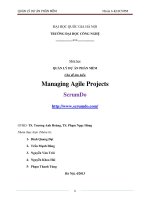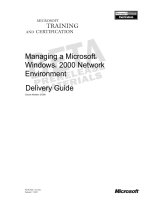Silicon Beach training PRINCE2 - Managing a Project
Bạn đang xem bản rút gọn của tài liệu. Xem và tải ngay bản đầy đủ của tài liệu tại đây (231.41 KB, 12 trang )
Silicon Beach Training
1
Silicon Beach Training
2
Contents
What is PRINCE2?
Benefits to using PRINCE2
Themes in PRINCE2
PRINCE2 Plans
PRINCE2 Approach to Plans
Progress
Setting Controls Covers
Risk Management
PRINCE2 Approach to Risk Management
Risk Management Procedure
Quality
PRINCE2 Approach to Quality
Change
Configuration Management
PRINCE2 Processes
Starting Up a Project
Initiating a Project
Directing a Project
Closing a Project
If you would like to learn more about PRINCE2 then Silicon Beach Training offer great
PRINCE2
Foundation Training, PRINCE2 Practitioner Training and also PRINCE2 Practitioner Conversion
Training.
Silicon Beach Training
3
What is PRINCE2?
PRINCE2 (PRojects IN Controlled Environments) is a structured method for effective project
management. It is a de facto standard used extensively by the UK Government and is widely
recognised and used in the private sector, both in the UK and internationally. PRINCE2, the method,
is in the public domain, offering non-proprietary best-practice guidance on project management.
PRINCE2 is a registered trademark of the Office of Government Commerce (OGC).
What makes projects different?
A project is a temporary organisation that is created for the purpose of delivering one or more
business products according to an agreed Business Case.
There are a number of characteristics of project work that distinguish it from business as usual -
• Change
• Temporary
• Cross-functional
• Unique
• Uncertainty
There are six variables that project managers wish to control and manage effectively -
• Costs
• Timescales
• Quality
• Scope
• Risk
• Benefits
The key features of PRINCE2 are -
• Its focus on the existence of a justified business case
• A clear defined organisation structure for the project management team
• A product-based planning approach
• Its emphasis on manageable, controllable stages
• Scalability and flexibility to be applied at a level appropriate to the project.
Benefits of using PRINCE2 -
The benefits of using the PRINCE2 methodology are -
• PRINCE2 embodies established and proven best practice and governance for project
management.
• It can be applied to any type of project – and can easily be implemented alongside specialist,
industry-specific models (’engineering models’ or ’development lifecycles’).
• PRINCE2 is widely recognized and understood, and therefore provides a common vocabulary
for all project participants – promoting effective communication.
Silicon Beach Training
4
• PRINCE2 provides for the explicit recognition of project responsibilities – so that participants
understand each other’s roles and needs.
• Its product focus clarifies (for all parties) what a project will deliver, why, when, by whom
and for whom.
• PRINCE2 plans are carefully designed to meet the needs of the different levels in the
management team, improving communication and control.
• It is based on a ’management by exception’ framework, providing for the efficient and
economic use of management time (whether at corporate, programme, Project Board or
project management levels).
• PRINCE2 ensures that participants focus on the viability of the project in relation to its
Business Case objectives – rather than simply seeing the completion of the project as an end
in itself.
• It defines a thorough but economical structure of reports.
• It ensures that stakeholders (including sponsors and resource providers) are properly
represented in planning and decision making.
• Adopting PRINCE2 promotes learning and continual improvement in organizations.
• PRINCE2 promotes consistency of project work and the ability to reuse project assets; it also
facilitates staff mobility and reduces the impact of personnel changes/handovers.
• PRINCE2 is an invaluable diagnostic tool, facilitating the assurance and assessment of project
work, troubleshooting and audits.
• There are scores of accredited training and consultancy organizations (ATOs and ACOs)
operating worldwide, who can supply expert support for PRINCE2 projects or for
organizations planning to adopt PRINCE2.
For senior management, PRINCE2 uses ‘management by exception’. The Project Board are kept fully
informed of the project and stage status without having to attend regular, time-consuming meetings
by way of planned controls, regular reports and exception situations which are brought to the
Boards attention at appropriate points.
They are also able to delegate some duties to Project Assurance who will act on their behalf to verify
and check at predetermined points in the project.
PRINCE2 may be used for any type of project in any type of environment; however it remains flexible
enough to be applied to all sizes of projects and can be tailored to suit a project dependent on the
circumstances.
PRINCE2 projects are focussed on delivering specified products to an agreed Business Case.
The Business Case is a key document which is reviewed constantly throughout the project and
progress is measured against expected and achieved benefits.
Themes in PRINCE2
PRINCE2 Plans -
The purpose of the Plans theme is to facilitate communication and control by defining the means
of delivering the products (the where and how, by whom, and estimating the when and how much).
Silicon Beach Training
5
Effective project management relies on effective planning as without a plan there is no control.
Planning provides all personnel involved in the project with information on:
• What is required
• How it will be achieved and by whom, using what specialist equipment and resources
• When events will happen
• Whether the targets (for time, cost, quality, scope, risk and benefits) are achievable.
The development and maintenance of credible plans provides a baseline against which progress can
be measured. They enable planning information to be disseminated to stakeholders in order to
secure any commitments which support the plan.
PRINCE2 approach to plans -
The development following activities will be used to create all levels of plan:
• Design the plan
• Define and analyse the products
• Identify activities and dependencies
• Prepare estimates
• Prepare the schedule
• Document the Plan
• Analyse the risks
Plans are produced at three levels in a PRINCE2 project.
© Crown Copyright 2009. Reproduced under Licence from OGC
• Initiation Stage Plan – this plan covers the activities of the initiation stage for the project.
• Project plan – this is the high level overall plan that covers the full duration of the project.
• Stage plan– this is an extract of the project plan covering a specific stage with more detail.
• Team plan – this is an optional plan which would contain a more detailed breakdown of a
section of the stage plan for use by a team when developing certain products.
Silicon Beach Training
6
• Exception plan – when a plan is predicted to no longer finish within the agreed tolerances,
an exception plan is produced to replace that plan.
• Benefits review plan – covers activities during and after the project to determine
achievement of benefits.
Progress -
The purpose of the Progress theme is to establish mechanisms to monitor and compare actual
achievements against those planned; provide a forecast for the project objectives and the project’s
continued viability; and control any unacceptable deviations.
Two of the principles of PRINCE2 are managing by stages and continued business justification. The
Progress theme provides the mechanisms for monitoring and control, enabling the critical
assessment of ongoing viability.
Another PRINCE2 principle is that projects are managed by exception, setting tolerances for project
objectives to establish limits of delegated authority. Tolerances define the amount of discretion that
each management level can exercise without the need to refer up to the next level for approval. The
Progress theme provides the mechanisms to monitor progress against the allowed tolerances, and
the controls to escalate to the next level should any forecast suggest that one or more tolerances
will be exceeded.
Control of progress is all about decision making and is central to project management, ensuring that
the project remains viable against its approved Business Case.
Setting controls covers:
• Authorisations – The stage breaks for Project Board decisions
• Progress updates – the frequency of highlight, checkpoint and end stage reports.
• Exceptions and changes – tolerances that apply, exception and change report requirements
Risk Management -
The purpose of the Risk theme is to identify, assess and control uncertainty and, as a result, improve
the ability of the project to succeed.
Risk taking in projects is inevitable since projects are enablers of change and change introduces
uncertainty, hence risk. Management of risk should be systematic and not based on chance. It is
about the proactive identification, assessment and control of risks that might affect the delivery of
the project’s objectives.
The project should establish and maintain a cost effective risk management procedure. The aim is to
support better decision making through a good understanding of risks – their causes, likelihood,
impact, timing, and the choice of responses to them.
Management of risk is a continual activity, performed throughout the life of the project. Without an
ongoing and effective risk management procedure it is not possible to give confidence that the
project is able to meet its objectives and therefore whether it is worthwhile for it to continue. Hence
effective risk management is a prerequisite of the continued business justification principle.
Silicon Beach Training
7
PRINCE2 Approach to Risk management -
For risk management to be effective, risks need to be:
• Identified This includes risks being considered that could affect the achievement of the
project’s objectives, and then described to ensure that there is a common understanding of
these risks
• Assessed This includes ensuring that each risk can be ranked in terms of estimated
likelihood, impact and immediacy, and understanding the overall level of risk associated with
the project
• Controlled This includes identifying appropriate responses to risks, assigning risk owners,
and then executing, monitoring and controlling these responses.
Risk Management procedure -
© Crown Copyright 2009. Reproduced under Licence from OGC
PRINCE2 recommends a risk management procedure comprising the following five steps:
• Identify (context and risks)
• Assess (i.e. Estimate and Evaluate)
• Plan
• Implement
• Communicate.
Silicon Beach Training
8
The first four steps are sequential, with the ’Communicate’ step running in parallel because the
findings of any of the other steps may need to be communicated prior to the completion of the
overall process. All of the steps are iterative in nature in that when additional information becomes
available, it is often necessary to revisit earlier steps and carry them out again to achieve the most
effective result.
Quality -
The purpose of the Quality theme is to define and implement the means by which the project will
create and verify products that are fit for purpose.
The Quality theme defines the PRINCE2 approach to ensuring that the project’s products:
• Meet business expectations
• Enable the desired benefits to be achieved subsequently.
The ’product focus’ principle is central to PRINCE2’s approach to quality. It provides an explicit
common understanding of what the project will create (the scope) and the criteria against which the
project’s products will be assessed (the quality). Without this understanding, the project would be
exposed to major risks (such as acceptance disputes, rework, uncontrolled change, user
dissatisfaction) that could weaken or invalidate the Business Case.
The Quality theme also covers the implementation of continuous improvement during the project –
for example, looking for ways to introduce more efficiency or effectiveness into the management of
the project and the project’s products. Capturing and acting on lessons contributes to the PRINCE2
quality approach, as it is a means of achieving continuous improvement.
PRINCE2 approach to quality -
The specific treatment for quality in PRINCE2 is the focus on products from the outset,
requiring systematic activities to:
• Identify all the project’s products (i.e. to the level at which the project intends to exert
control).
• Define them in Product Descriptions – including the quality criteria by which they will be
assessed; the quality methods to be used in designing, developing and accepting them; and
the quality responsibilities of those involved.
• Implement and track the quality methods employed throughout the project.
Change –
The purpose of the Change theme is to identify, assess and control any potential and approved
changes to the baseline.
Change is inevitable during the life of a project, and every project needs a systematic approach to
the identification, assessment and control of issues that may result in change.
As changes may arise from project team members, stakeholder requests, complaints or a wide range
of other factors, PRINCE2 provides a common approach to issue and change control.
Silicon Beach Training
9
Issue and change control is a continual activity, performed throughout the life of the project.
The aim of issue and change control procedures is not to prevent changes; it is to ensure that every
change is agreed by the relevant authority before it takes place.
Configuration Management -
The starting point for all projects will be to identify whether there are any corporate or programme
policies and processes that need to be applied, and incorporate them into the project’s own
Configuration Management Strategy. The project’s Configuration Management Strategy should
define:
• The configuration management procedure (e.g. planning, identification, control, status
accounting, verification and audit)
• The issue and change control procedure (e.g. capturing, examining, proposing, decision
making, implementing)
• The tools and techniques that will be used
• The records that will be kept
• How the performances of the procedures will be reported
• Timing of configuration management and issue and change control activities
• The roles and responsibilities for configuration management and issue and change control
activities (including whether any corporate or programme management roles are to be
involved).
PRINCE2 Processes
Starting Up a Project -
The purpose of the Starting up a Project process is to ensure that the prerequisites for Initiating a
Project are in place by answering the question: do we have a viable and worthwhile project?
This process is triggered by a mandate and is designed to establish the following:
• There is a business justification for initiating the project (documented in an outline Business
Case)
• All the necessary authorities exist for initiating the project
• Sufficient information is available to define and confirm the scope of the project (in the form
of a Project Brief)
• The various ways the project can be delivered are evaluated and a project approach selected
• Individuals are appointed who will undertake the work required in project initiation and/or
will take significant project management roles in the project
• The work required for project initiation is planned (documented in a Stage Plan)
• Time is not wasted initiating a project based on unsound assumptions regarding the
project’s scope, timescales, acceptance criteria and constraints.
Silicon Beach Training
10
Products produced during this process are as follows:
• Role descriptions
• Daily Log
• Lessons Log
• Outline Business Case
• Project Product Description
• Project Approach
• Project Brief
• Stage Plan
Initiating a Project -
The purpose of the Initiating a Project process is to establish solid foundations for the project,
enabling the organisation to understand the work that needs to be done to deliver the project’s
products before committing to a significant spend.
The objective of the Initiating a Project process is to ensure that there is a common understanding
of:
• The reasons for doing the project, the benefits expected and the associated risks
• The scope of what is to be done and the products to be delivered
• How and when the project’s products will be delivered and at what cost
• Who is to be involved in the project decision making
• How the quality required will be achieved
• How baselines will be established and controlled
• How risks, issues and changes will be identified, assessed and controlled
• How progress will be monitored and controlled
• Who needs information, in what format, and at what time
Other products created and ready for use when the project commences are:
• Risk Management Strategy and Risk Register
• Configuration Management Strategy, Initial Configuration Item Records and Issue Register
• Quality Management Strategy and Quality Register
• Communication Management Strategy
• Project Controls
• Role Descriptions
• Project Management Team Structure
• Project Plan
• Product Descriptions
• Benefits Review Plan
• Detailed Business Case
• Project Initiation Documentation
Directing a Project -
Silicon Beach Training
11
The purpose of the Directing a Project process is to enable the Project Board to be accountable for
the project’s success by making key decisions and exercising overall control while delegating day-to-
day management of the project to the Project Manager.
The objective of the Directing a Project process is to ensure that -
• There is authority to initiate the project
• There is authority to deliver the project’s products
• Management direction and control are provided throughout the project’s life, and that the
project remains viable
• Corporate or programme management has an interface to the project
• There is authority to close the project
• Plans for realising the post-project benefits are managed and reviewed.
The Directing a Project process starts on completion of the Starting up a Project process and is
triggered by the request to initiate a project.
Closing a Project -
The purpose of the Closing a Project process is to provide a fixed point at which acceptance for the
project product is confirmed, and to recognize that objectives set out in the original Project Initiation
Documentation has been achieved (or approved changes to the objectives have been achieved), or
that the project has nothing more to contribute.
The objective of the Closing a Project process is to -
• Verify user acceptance of the project’s products
• Ensure that the host site is able to support the products when the project is disbanded
• Review the performance of the project against its baselines
• Assess any benefits that have already been realized, update the forecast of the remaining
benefits, and plan for a review of those unrealized benefits
• Ensure that provision has been made to address all open issues and risks, with follow-on
action recommendations.
The main products of this process are as follows -
• Project Plan updated with final actual
• Product Status Account covering the status of all products for the project
• Issue register to identify any outstanding issues
• Follow-on action recommendations created with any outstanding issues to be addressed
• Configuration item records updated with current status of products
• Benefits review plan updated with dates for benefits realization
• Acceptance records for products completed
• End project report created
• Lessons Report created
• Close Issue, Risk, Quality registers, Daily and Lessons Log
Silicon Beach Training
12
If you would like to learn more about PRINCE2 then Silicon Beach Training offer great
PRINCE2
Foundation Training, PRINCE2 Practitioner Training and also PRINCE2 Practitioner Conversion
Training.









